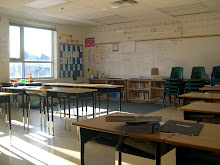Exhibit 8

Jesse shows continuous excitement with the character, Greedy Triangle. Nathan is more or less engaged in the same way as Jesse. His eye contact to Ms. Jane and the pictures of the book is consistent. From this, I can make some assumptions that both of them are attracted by characters that have a 'fun' personality. Stanley, the main character in Holes, is a young boy who always happens to be in the wrong place at the wrong time endures multiple mishaps. Perhaps, the two boys do find some similarities between Stanley and themselves. While Greedy Triangle is also a playful character who requests Shape Shaver to help him to get his body shaved and transform him into different shapes. I have a strong feeling that both boys are engaged with these characters because of their typical "boyish" personalities that they find connections to.

2 comments:
This is a good initial analysis. I wonder about some of the terms you use to describe Jesse. Be careful of deficit perspectives (Weiner); instead, remember that all student activity is purposeful, regardless of whether it seems "off task." Ask yourself what he is concentrating on, rather than saying that he is inattentive. Rather than assuming that he is unmotivated, ask yourself what is it about the literacy event that he does not find engaging. The other term I question is "boyish." Make sure to explain what you mean by that. What defines something as "boyish", and who says so? You might find the work of Bronwyn Davies helpful in this regard.
Revised Entry
In respect to what Grace has commented about this entry, I begin to think about why Jesse has been behaving in this manner in a consistent basis. Based on what I have been observing, I am implying that he is probably listening while he is fidgeting or gazing elsewhere when Ms. Jane is reading aloud, because often he does display facial expressions and comment on what he has heard, but he just does not show the “attentiveness”.
I would say the book Holes is a ‘boyish’ text. Stanley, a young boy who was accused of stealing a pair of shoes, and was later sent to Camp Green Lake to learn to ‘build character’ by digging holes. According to Maynard (2002), boys and girls enjoy different types of stories. For example, girls in their toddler years and on like to read about families, while boys like to read humor, adventure, and football. In addition, Maynard stated that girls are able to make connections to what they are reading to their own personal experiences, whereas boys, are mostly drawn to books that depicted stereotyped characters that they are likely to endorse their identity and experiences as ‘masculine’ boys. Boys are also reluctant to read books that their content, title and even picture focus on female characters. In light of this, I am going to continue with the checklist and strategy lessons that will focus on getting them “hooked” on the books they are reading, namely, choosing books that appeal to their interests, and encouraging making connections to their lives.
Post a Comment